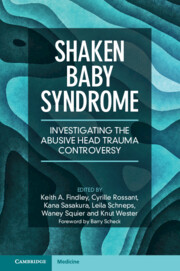Book contents
- Shaken Baby Syndrome
- Shaken Baby Syndrome
- Copyright page
- Dedication
- Contents
- Foreword
- About This Book
- Abbreviations
- Section 1 Prologue
- Section 2 Medicine
- Section 3 Science
- Chapter 10 The Swedish Systematic Literature Review on Suspected Traumatic Shaking (Shaken Baby Syndrome) and Its Aftermath
- Chapter 11 Interrogation and the Infanticide Suspect
- Chapter 12 Can Confession Substitute for Science in Shaken Baby Syndrome/Abusive Head Trauma?
- Chapter 13 Cognitive Bias in Medico-legal Judgments
- Chapter 14 Biomechanical Forensic Analysis of Shaking and Short-Fall Head Injury Mechanisms in Infants and Young Children
- Chapter 15 When Lack of Information Leads to Apparent Paradoxes and Wrong Conclusions
- Chapter 16 Epidemiology of Findings Claimed to Be Highly Specific for Shaken Baby Syndrome/Abusive Head Trauma, a Prerequisite to Improve Diagnosis of Child Abuse
- Chapter 17 Shaken Baby Syndrome
- Section 4 Law
- Section 5 International
- Section 6 Postface
- Appendix: Frequently Repeated Claims concerning Shaken Baby Syndrome
- Index
- Plate Section (PDF Only)
- References
Chapter 15 - When Lack of Information Leads to Apparent Paradoxes and Wrong Conclusions
Analysis of a Seminal Article on Short Falls
from Section 3 - Science
Published online by Cambridge University Press: 07 June 2023
- Shaken Baby Syndrome
- Shaken Baby Syndrome
- Copyright page
- Dedication
- Contents
- Foreword
- About This Book
- Abbreviations
- Section 1 Prologue
- Section 2 Medicine
- Section 3 Science
- Chapter 10 The Swedish Systematic Literature Review on Suspected Traumatic Shaking (Shaken Baby Syndrome) and Its Aftermath
- Chapter 11 Interrogation and the Infanticide Suspect
- Chapter 12 Can Confession Substitute for Science in Shaken Baby Syndrome/Abusive Head Trauma?
- Chapter 13 Cognitive Bias in Medico-legal Judgments
- Chapter 14 Biomechanical Forensic Analysis of Shaking and Short-Fall Head Injury Mechanisms in Infants and Young Children
- Chapter 15 When Lack of Information Leads to Apparent Paradoxes and Wrong Conclusions
- Chapter 16 Epidemiology of Findings Claimed to Be Highly Specific for Shaken Baby Syndrome/Abusive Head Trauma, a Prerequisite to Improve Diagnosis of Child Abuse
- Chapter 17 Shaken Baby Syndrome
- Section 4 Law
- Section 5 International
- Section 6 Postface
- Appendix: Frequently Repeated Claims concerning Shaken Baby Syndrome
- Index
- Plate Section (PDF Only)
- References
Summary
This chapter reviews the evidence showing that short falls may sometimes cause the types of bleeding typically attributed to shaken baby syndrome. Focusing on one seminal article dismissing short falls as a possible cause for fatal injury in infants, it examines in detail the statistical and reasoning errors that allowed the authors to reach their erroneous conclusion, an exercise all the more useful in that these are widespread throughout the literature. Based on numerous publications, the chapter adduces evidence showing that in fact, although they are rare, short falls can be dangerous.
- Type
- Chapter
- Information
- Shaken Baby SyndromeInvestigating the Abusive Head Trauma Controversy, pp. 236 - 248Publisher: Cambridge University PressPrint publication year: 2023

